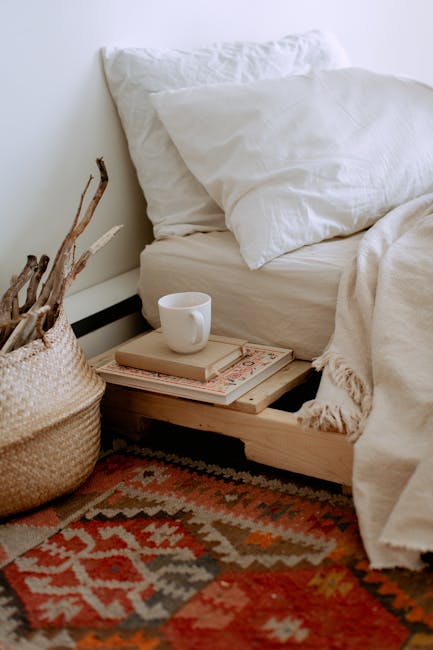Minimal & Modern Bedroom Designs That Prioritize Rest
Introduction
In today’s fast-paced world, the bedroom needs to be more than just a place to sleep. It should be a sanctuary, a retreat designed to promote rest and rejuvenation. Minimal and modern bedroom designs excel at creating this tranquil environment by focusing on simplicity, functionality, and a calming aesthetic. This article explores key elements of these designs, offering practical tips for transforming your bedroom into a haven for restorative sleep.
Creating a Minimal & Modern Bedroom for Rest
Embrace a Neutral Color Palette
Color psychology plays a significant role in sleep quality. Harsh, vibrant colors can be stimulating, making it harder to unwind. Opt for a neutral color palette such as:
- Soft Whites: Creates a clean and airy feel.
- Greys: Offers sophistication and tranquility.
- Beiges and Taupes: Provides warmth and grounding.
- Pastel Hues (Light Blues, Greens): Can be calming and serene, but use sparingly.
Consider using different shades of your chosen neutral to add depth and dimension without disrupting the overall calm.
Declutter and Simplify
Clutter is the enemy of relaxation. A minimalist bedroom prioritizes essential items and eliminates unnecessary distractions.
- Purge Unnecessary Items: Donate, sell, or discard items you no longer need or use.
- Optimize Storage: Utilize under-bed storage, built-in shelving, and closets effectively to keep items out of sight.
- Keep Surfaces Clear: Nightstands and dressers should be free of clutter, showcasing only essential items like a lamp, a book, or a small plant.
Choose Functional and Stylish Furniture
Modern bedroom furniture is characterized by clean lines, simple forms, and functionality. When selecting furniture, consider these aspects:
- Platform Beds: Offer a low-profile, minimalist aesthetic and can maximize space.
- Floating Nightstands: Create a sense of spaciousness and provide convenient storage.
- Minimalist Dressers: Choose dressers with clean lines and ample storage to keep clothing organized.
- Avoid Overcrowding: Select only necessary furniture pieces to maintain a sense of openness.
Prioritize Natural Light and Ventilation
Natural light and fresh air are crucial for regulating the body’s natural sleep-wake cycle.
- Maximize Natural Light: Keep windows uncovered during the day to allow sunlight to flood the room.
- Invest in Blackout Curtains: Block out unwanted light at night for deeper, more restful sleep.
- Ensure Proper Ventilation: Open windows regularly to circulate fresh air and maintain a comfortable temperature.
Incorporate Calming Textures and Materials
The textures and materials you choose can significantly impact the overall feel of your bedroom.
- Natural Fabrics: Opt for bedding made from breathable natural fibers like linen, cotton, or bamboo.
- Soft Rugs: Add warmth and comfort with a plush rug underfoot.
- Wood Accents: Incorporate wood elements to bring a sense of nature and tranquility into the space.
- Avoid Synthetic Materials: Minimize the use of synthetic materials, as they can trap heat and moisture, disrupting sleep.
Strategic Lighting Design
Lighting plays a crucial role in setting the mood for relaxation. Avoid harsh overhead lighting and opt for layered lighting options.
- Dimmer Switches: Install dimmer switches to adjust the brightness of your lights and create a relaxing ambiance.
- Table Lamps: Use table lamps on nightstands to provide soft, warm light for reading or relaxing.
- Floor Lamps: Add ambient lighting with a floor lamp in a corner of the room.
- Avoid Blue Light Before Bed: Minimize exposure to blue light from electronic devices for at least an hour before sleep.
Add Greenery (Sparingly)
Plants can enhance air quality and bring a sense of calm to your bedroom. However, avoid overcrowding the space with too many plants.
- Choose Low-Maintenance Plants: Opt for plants like snake plants, spider plants, or succulents that are easy to care for.
- Consider Air-Purifying Plants: Select plants that are known for their air-purifying properties.
- Place Plants Strategically: Position plants in areas where they will receive adequate light and won’t be easily knocked over.
Conclusion
Creating a minimal and modern bedroom that prioritizes rest is about more than just aesthetics; it’s about designing a space that supports your well-being. By embracing simplicity, decluttering, and incorporating calming elements, you can transform your bedroom into a tranquil sanctuary that promotes restful sleep and rejuvenation. Start small, focusing on one or two key changes at a time, and gradually create the bedroom of your dreams – a haven where you can truly unwind and recharge.




Post Comment